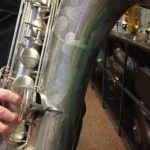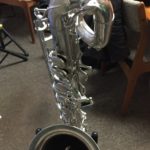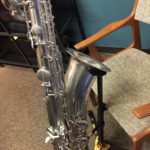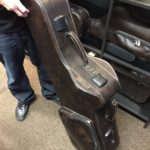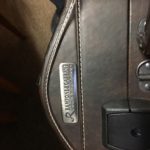Interview with Dr. Jared Sims by Tim Hecker
Interview by Tim Hecker.
Dr. Jared Sims is the current Director of Jazz at West Virginia University and the former Assistant Director of Jazz at the University of Rhode Island. He performs on all of the saxophones, clarinet and flute, and has recorded with such artists as Bob Brookmeyer, Cecil McBee, the Temptations, the Four Tops and many others. He has both toured internationally and inspired young artists at home as the guest conductor of All State ensembles in multiple states. This week, he was kind enough to take time out of his busy schedule in order to give an interview to jazzbarisax.com. Here’s what he had to say–
I know you play a lot of baritone- in fact, you once told me that you are a bari sax guy at heart. What kindled your fondness for the baritone sax? What keeps you coming back to it?
I like to say that I did not necessarily pick the baritone — the baritone picks me. I like it because it feels natural to me. The other saxes feel great too, but the baritone has always felt normal and in some ways easier for me. I first had the baritone in my hands when I was in the fifth grade. The band teacher tried to slow me down but instead I was playing bari in the high school jazz band by the end of my fifth grade year.
What artists and recordings have influenced you as a saxophonist, especially but not exclusively on baritone? To what degree do those who came before you influence your own recordings?
I really like the fire of Ronnie Cuber and Pepper Adams and the imagination of Sahib Shihab and Cecil Payne. Tradition is very important and to me. I think we have to reference tradition in our playing to add depth to our sound, but we also need to know the tradition in order to find new ways of presenting the music in terms of forms, or harmonies, or phrasing.
What is the first thing you notice when listening to a saxophonist, and what draws you to that element of playing?
I think the sound is the first thing. If the sound is not full or it is out of tune or uncentered, it is really hard to hear. Otherwise, I notice the phrasing and the rhythm of what is being played. In some ways the sound of the instrument is the HARDEST and MOST IMPORTANT thing that we can do on the saxophone but so often students do not make this a primary focus of study.
The classic question- what is your setup, and why is your equipment what it is? Do you think equipment makes a difference, or do you believe that it is all up to the player?
I have two baritone setups and go back and forth between them. One is a silver Buescher True Tone/Big B from the 1930s. It is a strange transitional horn and only about 900 of them were made. The other baritone is a silver Conn Naked Lady from the late 1940s. The mouthpieces that I use are a vintage Berg Larsen and a new Theo Wanne. I use Marca reeds either 2.5 or 3 strength.
I choose a setup based on the gig – the style and what instruments that I need to blend with. I think it’s up the player to live with the setup and not expect the setup to feel good right away. That said, I think players need to experiment a lot with every aspect of the setup — including where the ligature sits on the mouthpiece, the reed placement, etc. At the end of the day, though, yes a great player will sound great playing anything.
Another classic question- what is your practice routine? Do you have any practice rituals specific to bari sax?
My most recent favorite practice routine is to play 20 minutes on each instrument starting with flute, then clarinet, alto, tenor, and then baritone. My entire baritone technique is based on efficiency, which means that the air and the fingers and everything needs to be as perfect as possible to have the right sound and precision. That said, I could pick up a baritone cold without playing a bunch of other small instruments, but it’s good to have a nice long routine to put the air and fingers in the right place.
What are your interests outside of music? Do you find that they influence your playing, and if so in what way?
I really like to travel, to go to art museums, and to be outdoors. These are all things that help to investigate the creative process and to contemplate creativity.
Do you aim for certain qualities in your sound? What do you do to achieve the sound that you want?
I like a FULL sound with all of the different ranges of the sound included. Sometimes, I record myself and listen back to hear the true sound of the instrument. In general, mouthpiece sirens and overtones open up the sound. At this point, I have done a lot of that work so just making music and hearing my sound is enough to center the sound. A lot of musical issues get taken care of by simply having the horn in hand and spending time making music. It is all very intuitive to me.
If you could say one thing to people interested in specializing in bari sax, what would it be?
There is a misconception that the baritone takes a lot more air and that you have to play slower or fewer notes or perhaps play more simply on baritone. I think it probably does take some more air, but if the setup is right I think it is possible to do all of the same things on baritone that other sax players are doing.

